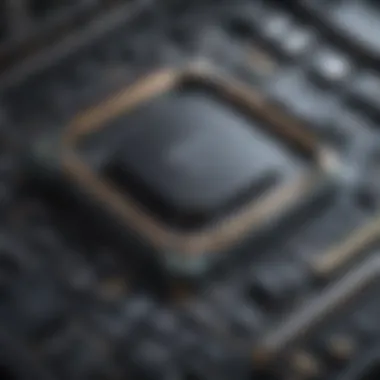Unraveling the Influence of Multi-Core Processors on Modern Computing Paradigms


Understanding the Evolution of Multi-Core Processors in Computer Architecture
In the intricate landscape of modern computing, the evolution of multi-core processors stands as a pivotal advancement. These processors have redefined computational capabilities by integrating multiple processing units on a single chip, enabling parallel execution of tasks to enhance speed and efficiency. This section will delve into the fundamental concepts behind multi-core processors, unraveling their transformative impact on computer architecture.
In the dynamic realm of computer architecture, the concept of multi-core processors emerges as a game-changer, disrupting traditional computing paradigms. By incorporating multiple processing cores on a single chip, these processors stimulate parallel processing, enabling simultaneous execution of tasks and significantly boosting computational performance. The evolution of multi-core processors marks a significant milestone in harnessing the full potential of modern computing systems.
Unveiling the Core Components of Multi-Core Processors
At the core of multi-core processors lie the individual processing units known as cores, each capable of executing instructions independently. These cores operate in harmony, dividing tasks among themselves to streamline operations and improve overall efficiency. Understanding the intricate interplay between these cores is essential in unlocking the true power of multi-core processors within the realms of modern computing.
Harnessing Parallelism for Enhanced Performance
One of the key advantages of multi-core processors lies in their ability to leverage parallelism for accelerated task execution. By distributing workloads across multiple cores, these processors can handle multiple tasks simultaneously, enhancing overall performance and productivity. Embracing parallelism unlocks a new realm of computational possibilities, making multi-core processors indispensable in today's demanding computing environments.
Overcoming Challenges with Multi-Core Architectures
Despite their profound benefits, multi-core processors also pose unique challenges in terms of software optimization, task allocation, and memory management. Balancing workload distribution, optimizing software for parallel execution, and addressing communication overhead between cores present complex hurdles that must be effectively navigated. Understanding and mitigating these challenges are crucial in maximizing the efficiency and effectiveness of multi-core processor systems.
Introduction to Multi-Core Processors
In the digital landscape of contemporary computing, understanding the significance of multi-core processors is paramount. Multi-core processors, characterized by the integration of multiple processing units on a single chip, have redefined the efficiency and performance benchmarks in computing systems. This section aims to delve into the core elements that underpin the operation of multi-core processors, highlighting their transformative potential in enhancing computational tasks across various domains.
Definition of Multi-Core Processors
Understanding the Concept of Multi-Core Processing
Delving into the realm of multi-core processing unveils a paradigm shift in computational architecture. The concept revolves around the consolidation of multiple processing cores on a single chip, enabling parallel execution of tasks. This unique characteristic fosters an exponential increase in processing power, allowing for enhanced performance and scalability in computing operations. The benefits of this approach manifest in accelerated task completion and improved efficiency, making multi-core processing a coveted choice for modern computing scenarios.
Evolution of Multi-Core Technology


From Single-Core to Multi-Core Systems
The evolution from single-core to multi-core systems marks a significant technological progression in the computing landscape. Transitioning from the constraints of single-core processors to the capabilities of multi-core architecture has revolutionized processing capabilities. By harnessing the power of multiple cores operating in unison, modern systems can handle complex computational tasks with unprecedented speed and efficiency. While presenting notable advantages in terms of performance and multitasking capabilities, the shift towards multi-core systems also introduces challenges in optimizing resource utilization and workload distribution.
Significance in Modern Computing
Improving Performance and Efficiency
The impact of multi-core processors on modern computing paradigms is underpinned by their unparalleled ability to enhance performance and efficiency. By facilitating simultaneous execution of tasks across multiple cores, these processors optimize computational workflows, thereby maximizing productivity. The efficiency gains achieved through parallel processing not only boost system performance but also contribute to reduced processing times and energy consumption. However, harnessing the full potential of multi-core technologies requires adept management of tasks and resources to mitigate synchronization and communication overheads effectively.
Functionalities of Multi-Core Processors
Multi-core processors are a fundamental component within the realm of modern computing. Their pivotal role lies in enhancing computational capabilities by enabling the simultaneous execution of multiple tasks. This functionality is crucial in maximizing the efficiency and performance of computing systems, allowing for tasks to be processed concurrently. By harnessing the power of parallel processing, multi-core processors offer a significant advantage in tackling demanding workloads efficiently.
Parallel Processing Capabilities
Simultaneous Execution of Tasks:
The essence of parallel processing capabilities is embodied in the ability of multi-core processors to execute tasks simultaneously. This feature allows for multiple operations to be performed at once, leveraging the collective strength of individual cores to enhance overall system performance. Simultaneous execution of tasks facilitates a dramatic reduction in processing time, enabling quicker completion of computations and operations. This parallelism is a key factor in boosting efficiency and accelerating task completion, making it a preferred choice for applications requiring high-speed data processing.
Task Allocation and Scheduling
Optimizing Workload Distribution:
Task allocation and scheduling play a vital role in optimizing the distribution of workloads across multi-core processors. By strategically assigning tasks to individual cores based on their availability and processing capabilities, workload distribution can be balanced effectively. This approach ensures that each core operates at an optimal level, preventing bottlenecks and maximizing overall system performance. The unique feature of workload distribution optimization lies in its ability to adapt dynamically to varying computational requirements, allowing for efficient utilization of processing resources.
Resource Sharing and Communication
Efficient Data Exchange Among Cores:
The seamless exchange of data among cores is a critical aspect of multi-core processor functionality. Efficient communication mechanisms enable cores to share information and collaborate on tasks effectively. This streamlined data exchange process facilitates coordinated efforts among cores, leading to enhanced system cohesion and synchronized operation. The unique feature of efficient data exchange lies in its ability to minimize latency and overhead, optimizing data transfer speeds and improving overall system efficiency.


Advantages of Multi-Core Systems
In the realm of modern computing, the significance of multi-core systems cannot be overstated. This section delves into the pivotal role played by multi-core processors in revolutionizing computational operations. Multi-core systems offer a myriad of advantages that contribute to enhanced performance, efficiency, and scalability in computing environments. Understanding these advantages is crucial for IT professionals and cybersecurity experts alike, as they navigate the complex landscape of technological advancements and innovations.
Enhanced Performance
Speed and Throughput Improvements
When it comes to evaluating the impact of multi-core processors on performance, the aspect of speed and throughput improvements emerges as a cornerstone. The ability of multi-core systems to process multiple tasks simultaneously results in a substantial boost in speed and overall throughput. This translates to reduced processing times, faster data handling, and enhanced system responsiveness. The inherent parallel processing capabilities of multi-core architectures empower computing devices to execute tasks in parallel, thereby maximizing performance metrics.
Furthermore, the utilization of multiple cores allows for efficient task distribution, enabling a more balanced workload allocation and utilization of computational resources. This leads to optimized resource utilization and improved overall system performance. The unique feature of speed and throughput improvements in multi-core systems lies in their ability to handle complex computational tasks with agility and precision, elevating the efficiency of computing processes.
Scalability and Flexibility
Adaptability to Diverse Workloads
One of the standout features of multi-core systems is their inherent scalability and flexibility, particularly in adapting to diverse workloads. The adaptability of multi-core processors to varying computational demands makes them a versatile choice for modern computing environments. Whether handling intensive processing tasks or managing multiple applications concurrently, multi-core systems exhibit a robust scalability that ensures optimal performance across a spectrum of workloads.
The key characteristic of adaptability to diverse workloads lies in the dynamic allocation of tasks among cores based on workload requirements. This dynamic task allocation mechanism allows multi-core processors to adjust processing priorities in real-time, ensuring efficient workload management and workload distribution. The unique feature of adaptability to diverse workloads enhances the flexibility of multi-core systems, making them adept at handling fluctuating computational demands while maintaining optimal performance levels.
Power Efficiency
Optimizing Energy Consumption
In the pursuit of energy efficiency, multi-core systems present a compelling solution through the optimization of energy consumption. Optimizing energy consumption is critical in modern computing infrastructures, where the demand for enhanced performance must be balanced with energy conservation efforts. Multi-core processors achieve power efficiency through intelligent power management strategies, such as dynamic voltage and frequency scaling, to adapt power consumption based on workload requirements.
The key characteristic of optimizing energy consumption in multi-core systems is the ability to dynamically adjust power settings to match the intensity of computing tasks. By efficiently managing energy consumption across cores, multi-core processors strike a fine balance between performance and power efficiency. The unique feature of optimizing energy consumption not only reduces operational costs but also contributes to environmental sustainability by minimizing the carbon footprint of computing operations.
Challenges in Utilizing Multi-Core Processors


Multi-core processors have transformed the landscape of modern computing, ushering in a new era of parallel processing and enhanced performance. Understanding and addressing the challenges associated with utilizing multi-core processors are paramount in maximizing their potential. In this section, we will delve into the intricacies of these challenges, shedding light on the complexities that come with harnessing the power of multiple cores. From complex programming paradigms to synchronization and communication overheads, these challenges play a crucial role in shaping the efficiency and efficacy of multi-core systems. Embracing these challenges opens up opportunities for innovation and optimization within the realm of modern computing.
Complex Programming Paradigms
In the realm of multi-core processors, achieving parallelization is a pivotal aspect that requires meticulous attention. Parallelization refers to the process of dividing tasks into smaller sub-tasks that can be executed simultaneously across multiple cores. This approach enhances efficiency and speeds up computations, making it a popular choice for optimizing multi-core performance. The unique feature of achieving parallelization lies in its ability to distribute workloads efficiently among cores, ensuring optimal utilization of computing resources. However, this approach also comes with challenges, such as managing dependencies between parallel tasks and ensuring synchronization to avoid conflicts. Balancing these advantages and disadvantages is key to overcoming the hurdles posed by complex programming paradigms in maximizing the potential of multi-core processors.
Synchronization and Communication Overheads
Effective coordination of tasks across cores is essential for the seamless operation of multi-core systems. Synchronization and communication overheads refer to the delays and resource consumption associated with ensuring that tasks are executed in harmony across multiple cores. Coordinating tasks across cores involves managing data dependencies, handling parallel execution, and synchronizing results to maintain the integrity of computations. The key characteristic of coordinating tasks across cores lies in its role in minimizing bottlenecks and optimizing workflow distribution. While this approach offers benefits in terms of improved performance and resource utilization, it also introduces complexities in managing shared resources and avoiding race conditions. Understanding the intricacies of synchronization and communication overheads is vital for mitigating challenges and enhancing the efficiency of multi-core systems.
Software Optimization Constraints
Maximizing multi-core performance hinges on overcoming software optimization constraints that influence the scalability and efficiency of computing tasks. Maximizing multi-core performance involves optimizing algorithms, enhancing memory management, and fine-tuning task scheduling to leverage the full potential of multi-core processors. The key characteristic of maximizing multi-core performance is its capacity to boost throughput and reduce latency by distributing workloads intelligently among cores. While this strategy offers advantages in terms of improved efficiency and responsiveness, it also presents challenges in terms of code complexity and debugging. Balancing the advantages and disadvantages of software optimization constraints is crucial in unleashing the true power of multi-core processors in modern computing environments.
Future Prospects of Multi-Core Technology
In understanding the future of multi-core technology, it is essential to grasp the trajectory of innovation driving modern computing. Multi-core processors represent a vital component in the evolution of computational systems, with a focus on enhancing performance and efficiency in a dynamic digital landscape. The integration of multi-core architectures opens up a realm of possibilities, catering to the increasing demand for advanced processing capabilities. As technology continually advances, the future prospects of multi-core technology lay the foundation for groundbreaking developments that will shape the course of computing.
Continued Innovation and Development
Advancements in Multi-Core Architectures
Delving into the advancements in multi-core architectures unveils a realm of intricate improvements geared towards optimizing processing power. These enhancements encompass a range of technical aspects, from increased core counts and improved clock speeds to enhanced cache systems and advanced instruction sets. The key characteristic of advancements in multi-core architectures lies in their ability to deliver parallel processing capabilities at a scale previously unseen. This intrinsic feature empowers systems to handle complex computational tasks with precision and speed. The distinct advantage of these advancements lies in their capacity to boost overall system performance and scalability, catering to diverse workloads effectively.
Integration with Emerging Technologies
AI, Io
T, and Big Data Applications
The integration of multi-core technology with emerging domains such as Artificial Intelligence (AI), Internet of Things (Io T), and Big Data applications signifies a significant leap towards a technologically interconnected world. The key characteristic of this integration revolves around the seamless collaboration between multi-core processors and these innovative technologies, harnessing the processing power to drive groundbreaking solutions. The unique feature of this integration lies in its ability to handle large volumes of data with efficiency, enabling real-time analytics and enhanced decision-making processes. While the advantages are evident in the accelerated computation and analysis capabilities, challenges such as data security and resource optimization also come into play, presenting a nuanced perspective on the integration's impact.
Potential Impact on Computing Paradigms
Shaping the Future of Computational Systems
Exploring the potential impact of multi-core technology on computing paradigms unveils a transformative shift towards more advanced and adaptable systems. The key characteristic of shaping the future of computational systems lies in the integration of multi-core processors as a cornerstone of innovative computing models. This paradigm shift offers a glimpse into a future where computing systems are not only faster and more efficient but also inherently flexible and scalable. The unique feature of this advancement is its potential to redefine traditional computing approaches and pave the way for new paradigms that prioritize performance optimization and resource utilization. While the advantages are prevalent in the form of enhanced computational capabilities, considerations surrounding programming complexity and system compatibility pose challenges that require thoughtful deliberation.



